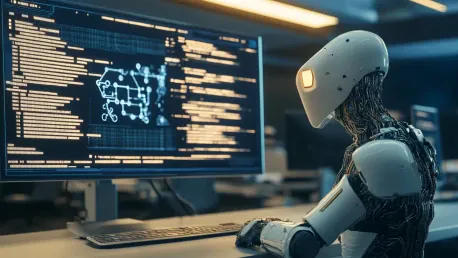The artificial intelligence (AI) industry is witnessing an intense rivalry as Anthropic makes significant strides to compete with OpenAI, another key player backed by tech giant Microsoft. Recently, Anthropic announced that it had raised $3.5 billion, bringing its total valuation to an impressive $61.5 billion. This capital influx is earmarked for the development of next-generation AI systems, expanding compute capacity, and enhancing research efforts. This announcement comes on the heels of the release of Anthropic’s latest models, Claude 3.7 Sonnet reasoning model and Claude Code, in February 2021. Given these advances, it’s evident that Anthropic aims to capture a substantial market share in the rapidly growing AI landscape.
Significance of Financial Backing
Competing Financial Backings
The financial endorsements secured by AI companies play a crucial role in determining their competitive edge and innovation capacity. Anthropic’s recent fundraising achievements are backed by prominent investors, including Lightspeed Venture Partners, Bessemer Venture Partners, Cisco Investments, D1 Capital Partners, Fidelity Management, and Salesforce. Although the $3.5 billion figure raised in this round is substantial, it remains relatively modest compared to other industry players. For instance, Databricks secured $15 billion, and OpenAI raised $6.6 billion in October. Furthermore, reports suggest that OpenAI could potentially secure an additional $40 billion from Softbank, significantly increasing its financial muscle.
This financial disparity underscores the steep challenges Anthropic faces in its quest to outpace OpenAI and other AI giants. Nevertheless, the valuation of $61.5 billion obtained by Anthropic highlights investor confidence in its strategic vision and long-term potential. It is also essential to consider that AWS and Azure, the cloud service providers backing Anthropic and OpenAI respectively, view AI as an integral facet of user experience rather than standalone operations. This positioning could prove advantageous as both Anthropic and OpenAI look to infuse AI capabilities seamlessly into broader technology ecosystems.
Investment Impact on Technology Development
The influx of funds will undoubtedly impact Anthropic’s technological development, enabling the company to advance its AI research and development efforts. By expanding its computing capacity and improving the performance of existing models, Anthropic aims to stay competitive in the AI market, characterized by rapid innovation cycles. The Claude 3.7 Sonnet reasoning model and Claude Code exemplify the firm’s commitment to pushing the boundaries of AI technology. Providing robust, scalable solutions is critical as these AI models gain traction across various industries, from finance to healthcare.
Moreover, with financial support from notable venture partners, Anthropic can attract top talent to drive its research initiatives forward. Employing experts in AI, machine learning, and data science is crucial in maintaining a competitive edge and fostering a culture of innovation. The ability to explore diverse AI applications also allows Anthropic to diversify its revenue streams, mitigating the risks associated with a highly competitive market. However, the challenge remains to operationalize these advanced models effectively, particularly as enterprises grapple with integrating AI into their existing systems and processes.
Challenges in AI Integration
Enterprise Integration Issues
Despite the rapid advancements in generative AI models, enterprises encounter significant hurdles when integrating these sophisticated technologies into their existing systems. The unique characteristics of enterprise data often necessitate tailored solutions, making it difficult for AI vendors like Anthropic and OpenAI to provide off-the-shelf products that meet diverse needs. This challenge can slow down the adoption rate of AI technologies, impeding the operationalization and realization of tangible benefits from AI investments.
The financial losses incurred by AI model providers due to these integration challenges highlight the critical need for customized approaches to AI deployment. David Nicholson from Futurum Group suggests that these AI companies might eventually transition from standalone entities to becoming integrated features within larger organizations. By embedding AI functionalities as part of comprehensive technology frameworks, companies can leverage AI capabilities more effectively, ensuring that they are aligned with business objectives and operational workflows.
Long-Term Viability and Market Position
Kjell Carlsson, head of AI Strategy at Domino Data Lab, emphasizes that Anthropic’s focus on safety, governance, and compliance distinguishes it from other major players in the AI sector. This strategic positioning has garnered significant investor interest and could be pivotal in addressing some of the integration challenges faced by enterprises. Ensuring compliance with regulatory standards and prioritizing data governance can build trust among users, facilitating wider acceptance of AI models across different sectors.
Moreover, the emphasis on safety and governance could position Anthropic favorably in market segments with stringent regulatory requirements, such as healthcare and finance. As these industries increasingly rely on AI for critical decision-making processes, the ability to demonstrate robust compliance and ethical standards becomes a competitive advantage. While the competition between Anthropic and OpenAI remains fierce, focusing on these areas could enable Anthropic to carve out a unique niche, securing long-term viability and market leadership.
Future Prospects in the AI Landscape
Potential Mergers and Partnerships
The broader AI industry appears to be gravitating towards larger mergers and partnerships as standalone AI functionalities become embedded within extensive tech ecosystems. This overarching trend suggests that AI model providers like Anthropic and OpenAI could eventually merge with or be acquired by larger technology companies. This integration would enable AI technologies to become a seamless component of broader technology stacks, enhancing their accessibility and utility across various applications.
The latest investment round for Anthropic, led by Lightspeed Venture Partners, indicates a broader interest in the strategic potential of AI technologies. As the competition intensifies, the ability to form alliances and partnerships will be crucial in maintaining a competitive edge. By aligning with larger tech firms, AI companies can leverage additional resources and expertise, accelerating their innovation cycles and expanding their market reach. This strategic approach could mitigate some of the financial and operational challenges associated with developing and deploying advanced AI models.
Strategic Positioning and Industry Impact
The artificial intelligence (AI) industry is experiencing fierce competition as Anthropic makes significant progress to challenge OpenAI, another major player supported by Microsoft. Recently, Anthropic revealed that it had secured $3.5 billion in funding, raising its total valuation to an impressive $61.5 billion. This capital is dedicated to the creation of next-generation AI systems, boosting compute capacity, and furthering research initiatives. This announcement follows the release of Anthropic’s latest models, Claude 3.7 Sonnet reasoning model and Claude Code, in February 2021. These advancements highlight Anthropic’s ambition to secure a substantial share of the rapidly expanding AI market. Given this, it’s evident that AI tech continues to advance, with Anthropic positioning itself as a formidable contender. As the industry evolves, the rivalry between these companies is likely to fuel innovation and push the boundaries of what’s possible with AI technology.









